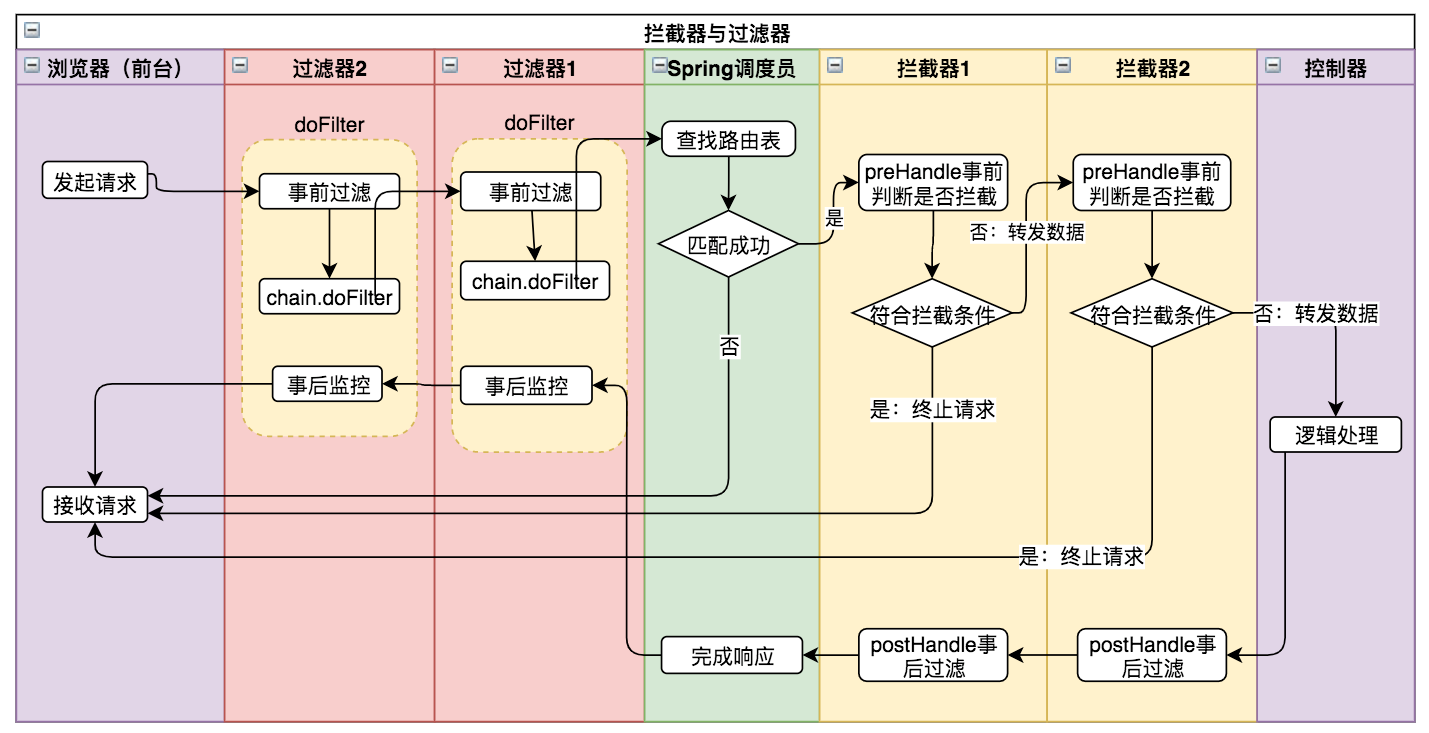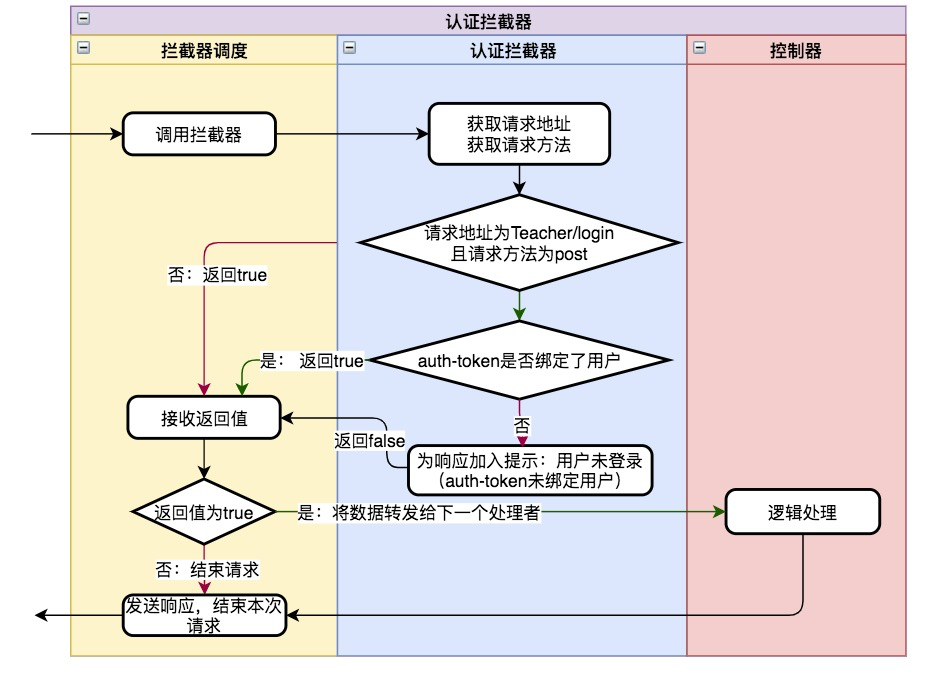spring中的攔截器與前面學習過的過濾器大同小異。它們都可以在數據被轉發到控制器前獲取數據。不同的是過濾器的功能是改變得到的數據從而完成一定的功能,而攔截器的功能體現在監視數據上,一旦發被被監視的數據不合規,攔截器可以直接終止數據的轉發并自定義返回的數據格式。在spring中,過濾器與攔截器都是支持多個的。在配置了多個過濾器與攔截器的項目中,數據首先依次通過過濾器,然后在依次通過攔截器。
>[info] 某些功能即可以使用攔截器來實現又可以使用過濾器來實現,這并沒有一定的界線。比如對將前臺的請求依次寫入日志,無論是攔截器還是過濾器都能夠滿足功能需求。但往往在對數據進行變更時使用過濾器,在對數據進行監視時使用攔截器。
# 初始化
攔截器的使用方法與過濾器基本一致。新建過濾器時直接繼承了HttpFilter,新建攔截器時直接繼承HandlerInterceptorAdapter就好。
interceptor/AuthInterceptor.java
```java
package com.mengyunzhi.springbootstudy.interceptor;
import org.springframework.web.servlet.handler.HandlerInterceptorAdapter;
/**
* 認證攔截器
* @author panjie
*/
public class AuthInterceptor extends HandlerInterceptorAdapter {
}
```
Spring的攔截器提供了4種方法,4種方法執行在各個階段。比較常用的是preHandle方法及postHandler方法,它們一個運行在控制器被執行前,另一個運行在控制器被執行后。
interceptor/AuthInterceptor.java
```java
@Component ?
public class AuthInterceptor extends HandlerInterceptorAdapter {
private static final Logger logger = LoggerFactory.getLogger(AuthInterceptor.class);
@Override
public boolean preHandle(HttpServletRequest request, HttpServletResponse response, Object handler)
throws Exception {
logger.info("執行攔截器preHandle");
return true;
}
@Override
public void postHandle(HttpServletRequest request, HttpServletResponse response, Object handler,
@Nullable ModelAndView modelAndView) throws Exception {
logger.info("執行攔截器postHandle");
}
}
```
* ? 使用Component進行注解,以便在項目中可以使用@Autowired注入
## 添加攔截器
與添加過濾器的方法有所不同,添加攔截器的方法稍微的復雜一些。使攔截器生效的方法是打開`config/WebConfig.java`去覆寫`addInterceptors`方法:
config/WebConfig.java
```java
public class WebConfig implements WebMvcConfigurer {
@Autowired
AuthInterceptor authInterceptor; ?
@Override
public void addInterceptors(InterceptorRegistry registry) {
registry.addInterceptor(this.authInterceptor?);
}
```
* ? 由于AuthInterceptor使用了@Component,所以此時可以使用@Autowired進行注入。
* ? 將自定義的攔截器使用registry.addInterceptor方法添加到系統中,spring啟動的過程中會自動的執行該方法以完成向項目中添加攔截器的目標。
## 測試
啟動后臺并嘗試訪問/Teacher/me接口,得到日志如下:
```
2020-02-19 17:38:42.926 INFO 27620 --- [nio-8080-exec-1] c.m.springbootstudy.filter.TokenFilter : 獲取到的token為8f03f582-4284-4b4e-85f2-258f30f016c0 ?
2020-02-19 17:38:42.926 INFO 27620 --- [nio-8080-exec-1] c.m.springbootstudy.filter.TokenFilter : 原token無效,發布的新的token為8e79419b-f632-4e4a-966b-6353f5647458 ?
2020-02-19 17:38:42.929 INFO 27620 --- [nio-8080-exec-1] c.m.springbootstudy.filter.TokenFilter : 在控制器被調用以前執行 ?
2020-02-19 17:38:42.933 DEBUG 27620 --- [nio-8080-exec-1] o.s.web.servlet.DispatcherServlet : GET "/Teacher/me", parameters={} ?
2020-02-19 17:38:42.937 DEBUG 27620 --- [nio-8080-exec-1] s.w.s.m.m.a.RequestMappingHandlerMapping : Mapped to public com.mengyunzhi.springbootstudy.entity.Teacher com.mengyunzhi.springbootstudy.controller.TeacherController.me() ?
2020-02-19 17:38:42.938 INFO 27620 --- [nio-8080-exec-1] c.m.s.interceptor.AuthInterceptor : 執行攔截器preHandle ?
2020-02-19 17:38:42.991 DEBUG 27620 --- [nio-8080-exec-1] m.m.a.RequestResponseBodyMethodProcessor : Using 'application/json', given [*/*] and supported [application/json, application/*+json] ?
2020-02-19 17:38:42.992 DEBUG 27620 --- [nio-8080-exec-1] m.m.a.RequestResponseBodyMethodProcessor : Nothing to write: null body ?
2020-02-19 17:38:42.992 INFO 27620 --- [nio-8080-exec-1] c.m.s.interceptor.AuthInterceptor : 執行攔截器postHandle ?
2020-02-19 17:38:42.992 DEBUG 27620 --- [nio-8080-exec-1] o.s.web.servlet.DispatcherServlet : Completed 200 OK ?
2020-02-19 17:38:42.994 INFO 27620 --- [nio-8080-exec-1] c.m.springbootstudy.filter.TokenFilter : 在控制器被調用以后執行 ?
```
* ? 執行過濾器的前置部分
* ? 執行spring內部路由
* ? 執行攔截器的preHandle方法
* ? spring處理控制器的返回值
* ? 執行攔截器的postHandle
* ? 完成響應,此后對響應的變更已經于事無補
* ? 執行過濾器的后置部分
所以大膽的猜測帶有多攔截器與過濾器的spring項目大概長這個樣子:

>[info] 此圖也解釋了在學習過濾器小節時遇到的于chain.doFilter之后改變reponse的值未生效的問題。
# 攔截請求
實現對用戶進行認證的功能適用于preHandle方法。

如圖所示:在preHandle方法中判斷用戶的每次請求是否是被允許,如果允許則不攔截,如果不允許則進行攔截。
interceptor/AuthInterceptor.java
```java
@Override
public boolean preHandle(HttpServletRequest request, HttpServletResponse response, Object handler)
throws Exception {
// 獲取請求地址及請求方法
// 判斷請求地址、方法是否與用戶登錄相同
// auth-token是否綁定了用戶
// 為響應加入提示:用戶未登錄
return true;
}
```
## 獲取請求地址及方法
獲取請求地址調用HttpServletRequest的getRequestURI方法,獲取請求方法調用HttpServletRequest的getMethod方法。
interceptor/AuthInterceptor.java
```java
public boolean preHandle(HttpServletRequest request, HttpServletResponse response, Object handler)
throws Exception {
// 獲取請求地址及請求方法
String url = request.getRequestURI();
String method = request.getMethod();
// 判斷請求地址、方法是否與用戶登錄相同
if ("/Teacher/login".equals(url) && "POST".equals(method)) {
return true;
}
```
## 判斷用戶是否登錄
在TeacherServiceImpl的me方法中已經處理過用戶是否登錄的邏輯:即判斷`TeacherServiceImpl`中的`authTokenTeacherIdHashMap`中是否存在以`authToken`為`key`的`teacherId`。如果存在則說此`authToken`已經與相應的`teacherId`進行綁定,從而得出攜帶有`authToken`的請求是經過用戶認證的。`authTokenTeacherIdHashMap`做為私有屬性存在于基于`TeacherServiceImpl`類實現的對象中:
service/TeacherServiceImpl.java
```java
public class TeacherServiceImpl implements TeacherService {
...
private HashMap<String, Long> authTokenTeacherIdHashMap = new HashMap<>();
}
```
實現讀取該authTokenTeacherIdHashMap的方法不止一種。
第一種方法:使用`public static`將`authTokenTeacherIdHashMap`聲明為靜態公有屬性,從而使其由對方的屬性上升到類的屬性。此后便可以在其它的方法中調用:`TeacherServiceImpl.authTokenTeacherIdHashMap.get(authToken)`來判斷某個`authToken`是否綁定了`teacherId`。但此方法違背了面向接口編程的思想。如果在攔截器中直接使用`TeacherServiceImpl`,則攔截器直接對`TeacherServiceImpl`這個實現類產生依賴,而非`TeacherService`接口。
第二種方法:在TeacherService中建立`boolean isLogin(String authToken);`方法,然后在實現類`TeacherServiceImpl`中實現這個方法。最后在攔截器中注入`TeacherService`。這與教程中的其它實現保持了統一。同時由于攔截器中聲明的依賴為`TeacherService`,從而符合了面向接口開發的思想。
>[info] 面向接口開發是一種思想,一種編程的規范。在此不必在意為什么要這么做,以及實際是怎么做的。簡簡單單有個了解就好。
service/TeacherService.java
```java
/**
* 判斷用戶是否登錄
* @param authToken 認證令牌
* @return
*/
boolean isLogin(String authToken);
```
service/TeacherServiceImpl.java
```java
@Override
public boolean isLogin(String authToken) {
// 獲取authToken映射的teacherId
Long teacherId = this.authTokenTeacherIdHashMap.get(authToken);
return teacherId != null;
}
```
在攔截器中注入相應的TeacherService服務并調isLogin方法完成用戶是否登錄的校驗。
interceptor/AuthInterceptor.java
```java
private TeacherService teacherService;
@Autowired
public AuthInterceptor(TeacherService teacherService) {
this.teacherService = teacherService;
}
...
// 判斷請求地址、方法是否與用戶登錄相同
if ("/Teacher/login".equals(url) && "POST".equals(method)) {
return true;
}
// auth-token是否綁定了用戶
String authToken = request.getHeader(TokenFilter.TOKEN_KEY);
if (this.teacherService.isLogin(authToken)) {
return true;
}
```
## 在響應中加入提示:用戶未登錄
用戶未登錄的提醒通常使用設置http狀態碼的方法來通知請求者。前面已經接觸了幾個常見的狀態碼,比如查詢信息成功時對應的狀態碼為200;創建數據成功時返回的狀態為201;更新或刪除數據成功時對應的狀態為204;請求的映射未找到的時對應的狀態碼為404;請求映射找到了但請求方法不匹配時對應的狀態碼為405;在進行參數綁定發生錯誤時對應的狀態碼為400。用戶未登錄時應向請求者發送401狀態碼。
interceptor/AuthInterceptor.java
```java
// auth-token是否綁定了用戶
String authToken = request.getHeader(TokenFilter.TOKEN_KEY);
if (this.teacherService.isLogin(authToken)) {
return true;
}
// 為響應加入提示:用戶未登錄
response.setStatus(401); ?
return false; ?
}
```
* ? 返回狀態碼401,表示當前請求只對認證用戶開放。但當前接收到的authToken未找到對應的認證用戶。
* ? 返回false,程序至此中斷不再向下進行轉發,將設置了狀態碼的response發送給請求者。
# 測試
在使用http request進行測試中,加入以下日志信息以更好的觀察者其它過程:
interceptor/AuthInterceptor.java
```java
public boolean preHandle(HttpServletRequest request, HttpServletResponse response, Object handler)
throws Exception {
// 獲取請求地址及請求方法
String url = request.getRequestURI();
String method = request.getMethod();
System.out.println(("請求的地址為" + url + "請求的方法為:" + method);
// 判斷請求地址、方法是否與用戶登錄相同
if ("/Teacher/login".equals(url) && "POST".equals(method)) {
System.out.println(("請求地址方法匹配到登錄地址,不攔截");
return true;
}
// auth-token是否綁定了用戶
String authToken = request.getHeader(TokenFilter.TOKEN_KEY);
if (this.teacherService.isLogin(authToken)) {
System.out.println(("當前token已綁定登錄用戶,不攔截");
return true;
}
System.out.println(("當前token未綁定登錄用戶,返回401");
// 為響應加入提示:用戶未登錄
response.setStatus(401);
return false;
}
```
controller/TeacherController.java
```java
@GetMapping("me")
public Teacher me() {
System.out.println("用戶成功的請求了me方法");
return this.teacherService.me();
}
```
## 未登錄請求ME
未登錄請求非login方法時,應該返回401.
```
GET http://localhost:8080/Teacher/me
HTTP/1.1 401
auth-token: 832787ed-597e-4f35-8702-562e7a83bf68
Content-Length: 0
Date: Thu, 20 Feb 2020 03:07:29 GMT
<Response body is empty>
Response code: 401?; Time: 122ms; Content length: 0 bytes
```
* ? 狀態碼為401,說明攔截成功
日志信息如下:
```
請求的地址為/Teacher/me請求的方法為:GET
當前token未綁定登錄用戶,返回401
```
未觸發TeacherController中的me方法,近一步說明攔截成功。
## 用戶登錄
有效用戶登錄
```
POST http://localhost:8080/Teacher/login
Content-type: application/json;
{"username": "zhaokaiqiang", "password":"yunzhi"}
```
響應:
```
POST http://localhost:8080/Teacher/login
HTTP/1.1 200
auth-token: d3bf3d7f-0663-4258-9c82-025073602181 ★
Content-Type: application/json;charset=UTF-8
Transfer-Encoding: chunked
Date: Thu, 20 Feb 2020 03:15:25 GMT
true ?
Response code: 200?; Time: 29ms; Content length: 4 bytes
```
* ? 返回了true,說明正常執行了login方法。攔截器未攔截
* ? 返回狀態碼200
* ★ 記錄該成功認證的token,備用
日志信息進一步說明攔截工作成功
```
請求的地址為/Teacher/login請求的方法為:POST
請求地址方法匹配到登錄地址,不攔截
```
無效用戶登錄
```
POST http://localhost:8080/Teacher/login
Content-type: application/json;
{"username": "test", "password":"yunzhi"}
```
響應信息:
```
POST http://localhost:8080/Teacher/login
HTTP/1.1 200
auth-token: 819943cb-b34a-4bfa-bf74-1ca18c95585c
Content-Type: application/json;charset=UTF-8
Transfer-Encoding: chunked
Date: Thu, 20 Feb 2020 03:18:43 GMT
false
Response code: 200; Time: 19ms; Content length: 5 bytes
```
## 使用成功登錄的authToken訪問me
使用登錄成功后臺返回的authToken★加入header信息。
```
GET http://localhost:8080/Teacher/me
auth-token: d3bf3d7f-0663-4258-9c82-025073602181
```
響應信息:
```
GET http://localhost:8080/Teacher/me
HTTP/1.1 200
auth-token: d3bf3d7f-0663-4258-9c82-025073602181
Content-Type: application/json;charset=UTF-8
Transfer-Encoding: chunked
Date: Thu, 20 Feb 2020 03:22:08 GMT
{
"id": 1,
"name": null,
"sex": true,
"username": "zhaokaiqiang",
"email": null,
"createTime": null,
"updateTime": null,
"password": "yunzhi"
}
Response code: 200; Time: 193ms; Content length: 126 bytes
```
使用已認證的authToken訪問后臺,成功的訪問了me方法并返回了正常信息。日志如下:
```
請求的地址為/Teacher/me請求的方法為:GET
當前token已綁定登錄用戶,不攔截
用戶成功的請求了me方法
```
近一步得到了驗證。
至此,有一個擁有認證功能的攔截器便成功的被完成了。
# 參考文檔
| 名稱 | 鏈接 | 預計學習時長(分) |
| --- | --- | --- |
| 源碼地址 | [https://github.com/mengyunzhi/spring-boot-and-angular-guild/releases/tag/step5.2.8](https://github.com/mengyunzhi/spring-boot-and-angular-guild/releases/tag/step5.2.8) | - |
| spring-mvc-handlerinterceptor | [https://www.baeldung.com/spring-mvc-handlerinterceptor](https://www.baeldung.com/spring-mvc-handlerinterceptor) | - |
| HttpServletRequest | [https://docs.oracle.com/javaee/6/api/javax/servlet/http/HttpServletRequest.html](https://docs.oracle.com/javaee/6/api/javax/servlet/http/HttpServletRequest.html) | - |
- 序言
- 第一章:Hello World
- 第一節:Angular準備工作
- 1 Node.js
- 2 npm
- 3 WebStorm
- 第二節:Hello Angular
- 第三節:Spring Boot準備工作
- 1 JDK
- 2 MAVEN
- 3 IDEA
- 第四節:Hello Spring Boot
- 1 Spring Initializr
- 2 Hello Spring Boot!
- 3 maven國內源配置
- 4 package與import
- 第五節:Hello Spring Boot + Angular
- 1 依賴注入【前】
- 2 HttpClient獲取數據【前】
- 3 數據綁定【前】
- 4 回調函數【選學】
- 第二章 教師管理
- 第一節 數據庫初始化
- 第二節 CRUD之R查數據
- 1 原型初始化【前】
- 2 連接數據庫【后】
- 3 使用JDBC讀取數據【后】
- 4 前后臺對接
- 5 ng-if【前】
- 6 日期管道【前】
- 第三節 CRUD之C增數據
- 1 新建組件并映射路由【前】
- 2 模板驅動表單【前】
- 3 httpClient post請求【前】
- 4 保存數據【后】
- 5 組件間調用【前】
- 第四節 CRUD之U改數據
- 1 路由參數【前】
- 2 請求映射【后】
- 3 前后臺對接【前】
- 4 更新數據【前】
- 5 更新某個教師【后】
- 6 路由器鏈接【前】
- 7 觀察者模式【前】
- 第五節 CRUD之D刪數據
- 1 綁定到用戶輸入事件【前】
- 2 刪除某個教師【后】
- 第六節 代碼重構
- 1 文件夾化【前】
- 2 優化交互體驗【前】
- 3 相對與絕對地址【前】
- 第三章 班級管理
- 第一節 JPA初始化數據表
- 第二節 班級列表
- 1 新建模塊【前】
- 2 初識單元測試【前】
- 3 初始化原型【前】
- 4 面向對象【前】
- 5 測試HTTP請求【前】
- 6 測試INPUT【前】
- 7 測試BUTTON【前】
- 8 @RequestParam【后】
- 9 Repository【后】
- 10 前后臺對接【前】
- 第三節 新增班級
- 1 初始化【前】
- 2 響應式表單【前】
- 3 測試POST請求【前】
- 4 JPA插入數據【后】
- 5 單元測試【后】
- 6 惰性加載【前】
- 7 對接【前】
- 第四節 編輯班級
- 1 FormGroup【前】
- 2 x、[x]、{{x}}與(x)【前】
- 3 模擬路由服務【前】
- 4 測試間諜spy【前】
- 5 使用JPA更新數據【后】
- 6 分層開發【后】
- 7 前后臺對接
- 8 深入imports【前】
- 9 深入exports【前】
- 第五節 選擇教師組件
- 1 初始化【前】
- 2 動態數據綁定【前】
- 3 初識泛型
- 4 @Output()【前】
- 5 @Input()【前】
- 6 再識單元測試【前】
- 7 其它問題
- 第六節 刪除班級
- 1 TDD【前】
- 2 TDD【后】
- 3 前后臺對接
- 第四章 學生管理
- 第一節 引入Bootstrap【前】
- 第二節 NAV導航組件【前】
- 1 初始化
- 2 Bootstrap格式化
- 3 RouterLinkActive
- 第三節 footer組件【前】
- 第四節 歡迎界面【前】
- 第五節 新增學生
- 1 初始化【前】
- 2 選擇班級組件【前】
- 3 復用選擇組件【前】
- 4 完善功能【前】
- 5 MVC【前】
- 6 非NULL校驗【后】
- 7 唯一性校驗【后】
- 8 @PrePersist【后】
- 9 CM層開發【后】
- 10 集成測試
- 第六節 學生列表
- 1 分頁【后】
- 2 HashMap與LinkedHashMap
- 3 初識綜合查詢【后】
- 4 綜合查詢進階【后】
- 5 小試綜合查詢【后】
- 6 初始化【前】
- 7 M層【前】
- 8 單元測試與分頁【前】
- 9 單選與多選【前】
- 10 集成測試
- 第七節 編輯學生
- 1 初始化【前】
- 2 嵌套組件測試【前】
- 3 功能開發【前】
- 4 JsonPath【后】
- 5 spyOn【后】
- 6 集成測試
- 7 @Input 異步傳值【前】
- 8 值傳遞與引入傳遞
- 9 @PreUpdate【后】
- 10 表單驗證【前】
- 第八節 刪除學生
- 1 CSS選擇器【前】
- 2 confirm【前】
- 3 功能開發與測試【后】
- 4 集成測試
- 5 定制提示框【前】
- 6 引入圖標庫【前】
- 第九節 集成測試
- 第五章 登錄與注銷
- 第一節:普通登錄
- 1 原型【前】
- 2 功能設計【前】
- 3 功能設計【后】
- 4 應用登錄組件【前】
- 5 注銷【前】
- 6 保留登錄狀態【前】
- 第二節:你是誰
- 1 過濾器【后】
- 2 令牌機制【后】
- 3 裝飾器模式【后】
- 4 攔截器【前】
- 5 RxJS操作符【前】
- 6 用戶登錄與注銷【后】
- 7 個人中心【前】
- 8 攔截器【后】
- 9 集成測試
- 10 單例模式
- 第六章 課程管理
- 第一節 新增課程
- 1 初始化【前】
- 2 嵌套組件測試【前】
- 3 async管道【前】
- 4 優雅的測試【前】
- 5 功能開發【前】
- 6 實體監聽器【后】
- 7 @ManyToMany【后】
- 8 集成測試【前】
- 9 異步驗證器【前】
- 10 詳解CORS【前】
- 第二節 課程列表
- 第三節 果斷
- 1 初始化【前】
- 2 分頁組件【前】
- 2 分頁組件【前】
- 3 綜合查詢【前】
- 4 綜合查詢【后】
- 4 綜合查詢【后】
- 第節 班級列表
- 第節 教師列表
- 第節 編輯課程
- TODO返回機制【前】
- 4 彈出框組件【前】
- 5 多路由出口【前】
- 第節 刪除課程
- 第七章 權限管理
- 第一節 AOP
- 總結
- 開發規范
- 備用